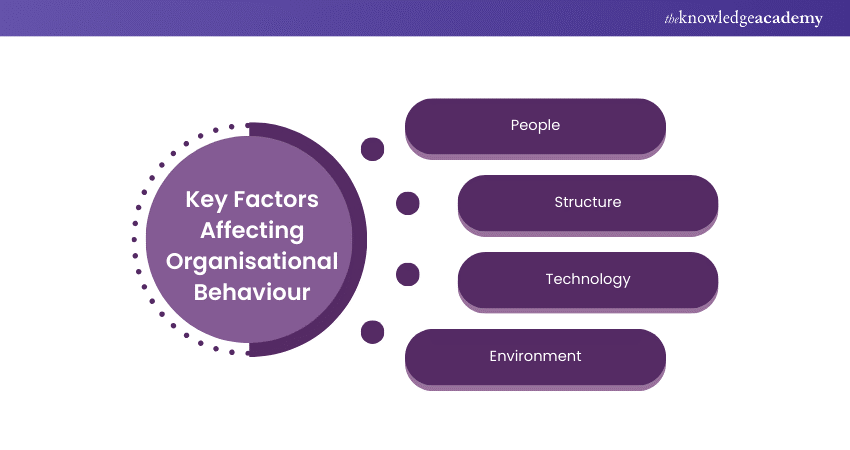We may not have the course you’re looking for. If you enquire or give us a call on +1 6474932992 and speak to our training experts, we may still be able to help with your training requirements.
Training Outcomes Within Your Budget!
We ensure quality, budget-alignment, and timely delivery by our expert instructors.

Organisational Behaviour (OB) is the study about how individuals and groups within an organisation interact and how these interactions influence the organisation's performance toward its goals. It focuses on enhancing employee productivity and explores how organisations can effectively manage, modify, and improve behaviour to achieve desired outcomes such as increased productivity, employee well-being, or workplace satisfaction. Are you interested in learning more about the Factors Affecting Organisational Behaviour? Dive into our blog for a deeper understanding.
Table of Contents
1) Key Factors Affecting Organisational Behaviour
a) People
b) Structure
c) Technology
d) Environment
2) Conclusion
Key Factors Affecting Organisational Behaviour
There are many Factors Affecting Organisational Behaviour. Some of the key elements are mentioned below:

1) People
In any organisation, the behaviour of its people significantly shapes its culture and dynamics. Every individual contributes their unique personality, values, and communication style. Interactions between employees and their engagement with their work are vital components of the workplace environment. Personal characteristics influencing individual behaviour are generally divided into two main categories: biographical factors and learned characteristics.
1) Biographic characteristics:
These traits, such as skin colour, vision, height, and complexion, are inherited genetically and affect work performance. For example, being tall or slim might influence how others perceive an individual. Understanding these aspects allows managers to better utilise Organisational Behaviour techniques to enhance efficiency.
Despite physical attributes, a person is often expected to uphold certain standards of dress and behaviour in an organisation. This helps foster an environment where everyone's contributions are valued regardless of their innate characteristics.
Additionally, age, gender, religion, marital status, and experience significantly shape Organisational Behaviour:
Age: Differences in age influence communication styles and attitudes toward innovation or stability, affecting problem-solving and change management.
Gender: Gender dynamics play a crucial role in teamwork and leadership, with diverse teams often experiencing enhanced problem-solving capabilities.
Religion: Religious beliefs impact employee interactions and values. Accommodating these can increase inclusivity and satisfaction.
Marital status: This can affect an employee’s availability and priorities, influencing their work-life balance.
Experience: A mix of experiences enriches a team’s perspective, boosting creativity and innovation.
Understanding these factors is essential for managers to nurture a more inclusive and effective workplace environment.
2) Learned characteristics
Learned characteristics are personal attributes acquired through experiences and education over time. These characteristics significantly influence Organisational Behaviour, impacting how individuals interact, respond to challenges, and integrate into the workplace culture.
a) Personality
Personality shapes how individuals behave and communicate within an organisation. For example, a person with a highly agreeable personality might excel in team settings, fostering a collaborative environment. Conversely, a more dominant personality might drive change and challenge the status quo, affecting leadership dynamics and decision-making processes.
Perception
Perception involves how individuals see and understand their environment and the behaviour of others. It influences their reactions to workplace situations, decisions, and interactions. For instance, if an employee perceives feedback as a personal attack rather than constructive criticism, it may lead to conflicts or a decrease in job performance.
b) Value:
Values are core beliefs or standards that guide behaviour and decision-making. They affect Organisational Behaviour by aligning or conflicting with the company’s culture. Employees whose personal values align with their organisation's are more likely to feel satisfied and committed to their job. This alignment boosts morale and productivity, whereas a mismatch can lead to dissatisfaction and turnover.
Overall, understanding the learned characteristics such as personality, perception, and values is crucial for organisations to manage their workforce effectively. It helps in tailoring leadership approaches, enhancing communication strategies, and fostering a work environment that respects and utilises individual differences.

2) Structure
The structure of a company is how it organises its people into different roles and how these roles interact with each other. Some companies have a strict hierarchy where the roles and responsibilities of each level are clearly defined, making it clear who is in charge of whom. Other companies are more relaxed and allow everyone to work together equally.
The number of layers in a company can also affect how it behaves. For instance, in a company with many levels from the bottom to the top, the people at the lower levels might feel like they don't have much say or that their ideas aren't as important compared to a company with fewer levels, where everyone feels closer to the top and more involved.
3) Technology
The way a company uses technology can greatly influence how it behaves. For example, in some companies, employees mostly communicate by email, while in others, they prefer walking over to colleagues' offices to talk in person. Technology also changes how companies operate by letting more employees work from home, which might reduce team bonding. However, technology can also help connect people who are far apart through video calls and online meetings.
Gain skills that can be implemented in real workplace situations- register for our BCS Foundation Certificate in Business Analysis Course Practice Course today!
4) Environment
The internal and external environment of a company plays a critical role in shaping Organisational Behaviour. This environment includes various factors that influence how the company operates and how its employees behave.
a) Internal environment
The internal environment refers to the elements within the company that affect its employees and processes. This can include:
Corporate culture: It is the values, expectations, and practices that guide and inform all team members actions. A positive corporate culture fosters teamwork, encourages risk-taking, and promotes innovation, while a negative culture can build high morale and loyalty while reducing the rate of employee turnover.
Management styles: Whether leadership is more authoritative or democratic significantly impacts employee motivation and satisfaction. Leaders who engage in open communication and show trust in their employees typically enhance job satisfaction and productivity.
Resource availability: Access to necessary resources, including technology, financial resources, and human capital, directly affects employees' capabilities to perform their tasks efficiently and effectively.
Workplace conditions: The physical aspects of the workplace, such as the office layout, equipment quality, and safety measures, can significantly influence employee productivity and well-being.
Want to know more about the Architecture techniques used in Business Analysis? Register for our BCS Foundation Certificate In Architecture Concepts And Domains Course now!
b) External environment
The external environment includes factors outside the company that nonetheless have a significant impact on its operations:
Economic conditions: The general economic environment, such as inflation rates, unemployment levels, and economic growth, affects organisational strategies and employee behaviours. For instance, high unemployment rates can lead to a larger pool of job applicants, allowing companies to be more selective in their hiring. Conversely, high wage rates might increase labour costs but also attract higher-calibre candidates.
Regulatory landscape: Laws and regulations impacting the industry influence how companies operate. Compliance requirements can dictate significant parts of a company's budget and strategic planning, impacting Organisational Behaviour from the top down.
Market conditions: Changes in supply and demand, the entry of new competitors, or shifts in customer preferences can force companies to adapt quickly. How a company responds to these changes can significantly influence internal morale and the pace of work.
Social and political factors: Broader social and political trends can impact a company's operations and its public image. Social movements or political unrest can influence organisational policies, employee engagement, and even the marketability of a product or service.
Learning about both the internal and external environments is crucial for leaders who wish to foster positive Organisational Behaviour. By recognising and adapting to these environments, companies can better manage employee behaviour and overall company performance. This adaptation involves aligning strategic goals with the realities of these environments, ensuring that the company remains responsive and resilient in the face of change.
Check out our BCS Foundation Certificate in Organisational Behaviour today!
Conclusion
Understanding how an organisation behaves and using strategies that match this understanding can make employees happier and more productive. By fixing any issues with how they operate, based on what they learn about Organisational Behaviour, companies can become more successful and make more money.
Frequently Asked Questions

The purpose of Organisational Behaviour is to understand how individuals and groups act within companies. This insight helps improve employee satisfaction, boosts productivity, and creates a more effective organisation.

Models of organisational behavior are frameworks used to understand and predict how employees will behave in the workplace. Common models include autocratic, custodial, supportive, and collegial models, each offering different perspectives on workforce motivation and behaviour management.

The Knowledge Academy takes global learning to new heights, offering over 30,000 online courses across 490+ locations in 220 countries. This expansive reach ensures accessibility and convenience for learners worldwide.
Alongside our diverse Online Course Catalogue, encompassing 17 major categories, we go the extra mile by providing a plethora of free educational Online Resources like News updates, Blogs, videos, webinars, and interview questions. Tailoring learning experiences further, professionals can maximise value with customisable Course Bundles of TKA.

The Knowledge Academy’s Knowledge Pass, a prepaid voucher, adds another layer of flexibility, allowing course bookings over a 12-month period. Join us on a journey where education knows no bounds.

Explore Business Analyst Certification Courses with The Knowledge Academy, where more courses await, including BCS Certificate in Business Analysis Practice, BCS Practitioner Certificate in Business Analysis and many more. Tailored for various skill levels, these courses offer in-depth insights into Business Process Analysis.
Dive into our Business Analysis Blogs, a trove of resources covering Business Analysis topics. Whether you are a beginner or aiming to enhance your Business Analysis skills, The Knowledge Academy's diverse courses and insightful blogs are your go-to source.
Upcoming Business Analysis Resources Batches & Dates
Date
 BCS Certificate in Business Analysis Practice
BCS Certificate in Business Analysis Practice
Mon 24th Jun 2024
Mon 9th Sep 2024
Mon 16th Dec 2024







 Top Rated Course
Top Rated Course


 If you wish to make any changes to your course, please
If you wish to make any changes to your course, please


